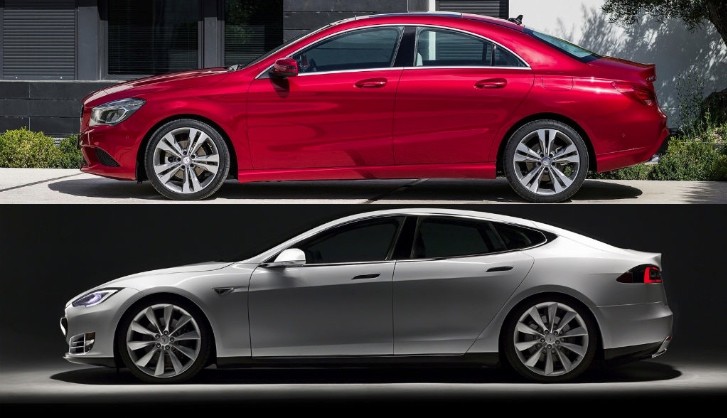There are many ways in which you can make certain car lovers lose respect for you when you are an automotive journalist, and building an entire premise over wrong or unsubstantiated facts is certainly one of them.
Let's have a look at Car and Driver's Don Sherman, for example, who recently wrote a rather lengthy article in which he meticulously describes how the “world's most aerodynamic production car” - the Mercedes-Benz CLA - is actually less slippery through the air than three other hybrid and electric production cars – namely the Chevrolet Volt, Toyota Prius and the Tesla Model S P85.
The story's... backstory is that Car and Driver received five cars known for their alleged aerodynamic properties and took them to an undisclosed location (of course!), where a wind tunnel facility filled with professional aero engineers was based.
In short, those aero engineers went to test each of the models in the wind tunnel, and the final aero comparison results found out that the Tesla Model S has the same 0.24 Cd as Tesla officially states, while the Mercedes-Benz CLA only achieved a rather disappointing Cd of 0.30, making it much less aerodynamic than what Mercedes-Benz says.
What is our beef with the above conclusion, you may ask? Well, let's start with the alleged facts that Don Sherman quotes when talking about the CLA.
Apparently, when Mercedes-Benz first unveiled their MFA-based CLA “four-door coupe” back in 2013, Mr. Sherman somehow understood that all CLA models will sport the “most aerodynamic car in the world” moniker.
Truth be told, a somewhat typical American ignorance concerning European cars somehow transpired from that statement, because he is actually very wrong.
The only Mercedes-Benz CLA model that actually is the aerodynamic benchmark for current production cars is the CLA 180 BlueEfficiency Edition, a variant of the small “four-door coupe” that will never be available in the US.
With an official drag coefficient of 0.22, it bests the Tesla Model S by two whole points. On the other hand, a European-spec Mercedes-Benz CLA 250 sports a Cd of 0.28, which is still two points more optimistic than what Car and Driver's aero test concluded.
Even so, what Don Sherman doesn't properly explain is that the US variant of the CLA 250 – the car they actually tested in the wind tunnel – doesn't sport the same aerodynamic mods as its European counterpart, such as active engine grille shutters, which make a tremendous difference in the car's drag coefficient at high speeds. In other words, the US-spec CLA 250 may very well sport a Cd of 0.30, could it not?
After all said and done, the aero comparison test you can view below could be as accurate as they get, but its conclusion is certainly not. As aerodynamic as it is, the Tesla Model S is still not more slippery through the air as a Mercedes-Benz CLA 180 BlueEfficiency model.
The story's... backstory is that Car and Driver received five cars known for their alleged aerodynamic properties and took them to an undisclosed location (of course!), where a wind tunnel facility filled with professional aero engineers was based.
In short, those aero engineers went to test each of the models in the wind tunnel, and the final aero comparison results found out that the Tesla Model S has the same 0.24 Cd as Tesla officially states, while the Mercedes-Benz CLA only achieved a rather disappointing Cd of 0.30, making it much less aerodynamic than what Mercedes-Benz says.
What is our beef with the above conclusion, you may ask? Well, let's start with the alleged facts that Don Sherman quotes when talking about the CLA.
Apparently, when Mercedes-Benz first unveiled their MFA-based CLA “four-door coupe” back in 2013, Mr. Sherman somehow understood that all CLA models will sport the “most aerodynamic car in the world” moniker.
Truth be told, a somewhat typical American ignorance concerning European cars somehow transpired from that statement, because he is actually very wrong.
The only Mercedes-Benz CLA model that actually is the aerodynamic benchmark for current production cars is the CLA 180 BlueEfficiency Edition, a variant of the small “four-door coupe” that will never be available in the US.
With an official drag coefficient of 0.22, it bests the Tesla Model S by two whole points. On the other hand, a European-spec Mercedes-Benz CLA 250 sports a Cd of 0.28, which is still two points more optimistic than what Car and Driver's aero test concluded.
Even so, what Don Sherman doesn't properly explain is that the US variant of the CLA 250 – the car they actually tested in the wind tunnel – doesn't sport the same aerodynamic mods as its European counterpart, such as active engine grille shutters, which make a tremendous difference in the car's drag coefficient at high speeds. In other words, the US-spec CLA 250 may very well sport a Cd of 0.30, could it not?
After all said and done, the aero comparison test you can view below could be as accurate as they get, but its conclusion is certainly not. As aerodynamic as it is, the Tesla Model S is still not more slippery through the air as a Mercedes-Benz CLA 180 BlueEfficiency model.


